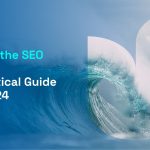From intro to CTA: How to write an article that keeps readers engaged

Writing an article with a title that encourages clicks is only half the job. Now you need to get them to take action, whether it's signing up for a free trial, subscribing to a newsletter, or scheduling a call.
And how do you go about it?
Using strategies that capture the reader's attention from the first line, keep them engaged throughout the article and show them exactly what to do next.
In this post, you'll learn how to use the following tactics to engage your readers:
- Writing according to the pyramid model
- Use of content patterns
- Implementation of an overarching story or theme
- Enrichment of your content
- With a clear conclusion
- Inclusion of call-to-actions
- Implementation of best practices for copywriting
Follow the pyramid model
The goal of this principle is to provide the most important information in the introduction. In short, you want to fulfill the search intent in the first paragraph.
The pyramid model goes back to the journalistic principle that an article should always mention the most important information first before going into details.
This principle has since been applied to executive summaries and also applies to blog posts.
Depending on the study you're reading, it takes a user anywhere from 50 milliseconds to 15 seconds to decide if your content is interesting enough to read... or if they'll click the back button. If your article starts with a long personal story that has nothing to do with the search term a user found you through, you've probably lost them before they get to the actual content.
Use a content pattern
The term content pattern in this sense was coined by Shane Melaugh of Thrive Themes. He developed the model to help content creators move effortlessly from a blank page with a blinking cursor to a cohesive, fully written article.
Essentially, each article consists of five main parts:
- Headline
- Introduction (using the pyramid principle)
- Content pattern
- Conclusion
- Call to action
In the middle part, things get interesting. Content patterns make the writing process more efficient by giving the writer a format to follow.
You can be more creative with content samples than with a generic bulleted list (e.g., "22 retention practices you should implement in 2021") without getting writer's block.
Example:
You write an article comparing two SaaS solutions for invoicing. Each solution has a set of features, a specific price tag, its own way of offering customer service, and so on.
The entire article would then look like this:
- Headline
- Introduction
- Content sample
- Person: Who is this comparison for?
- Problem: What problems does this persona have with billing tools?
- Solution: Two common software tools - and which is the best?
- Feature 1:Your heading indicating which feature is covered in this section.
- Assessment 1: how SaaS A performs with respect to characteristic 1.
- Assessment 2: how SaaS B performs in relation to characteristic 1.
- Winner: which SaaS is the best for Feature 1
- Feature 2:Your heading, which indicates which feature is covered in this section
- Assessment 1: how SaaS A performs in relation to characteristic 2.
- Assessment 2: how SaaS B performs in relation to characteristic 2.
- Winner: which SaaS is best for Feature 2
- Feature 3: Your heading indicating which feature is covered in this section.
- Assessment 1: how SaaS A performs with respect to characteristic 1.
- Assessment 2: how SaaS B performs in relation to characteristic 1.
- Winner: which SaaS is best for feature 1
- …
- Conclusion
- CTA
We call this content pattern "Person, Problem, Solution".
Instead of simply listing features, you have embedded the information into a cohesive story that leads to a result. And you didn't have to come up with this outline yourself, you just followed the content pattern.
Enrich your content
Humans are narrative creatures, and so you probably won't write an article in which every sentence has a purely literal meaning. However, a good article needs more than just a bit of figurative language to come to life, and it needs much more to engage the easily distracted online reader.
Here are some tactics that will not only encourage users to scroll, but also help you get your point across.
Use metaphors, examples, and personal stories
Metaphors, examples, and anecdotes clarify what you are explaining.
Metaphors do this by comparing abstract concepts and theoretical strategies to something the reader already knows, while examples and anecdotes embed them in real-life situations and help the reader understand how they might be useful to them.
Finally, a personal story makes your article more believable. Using statistics is another way to enrich your blog posts. The better you know the niche, brand, and target audience you are writing SEO copy for, the easier it will be to know which techniques to use and when.
Embed quotes
Citations often serve a dual purpose in an article.
By quoting an expert, you make a connection between what you are saying and that expert and give your article more authority. By quoting a satisfied customer, you build trust and social proof.
At the same time, you can use quotes to visually break up the text by giving them their own paragraph and styling. You can make them bold or italic or add a colored background behind them.
Save money on marketing by teaching your customers instead of buying their attention.
David Perell
https://twitter.com/david_perell/status/1269465321141723136
Include visuals
Another way to break up a long text is to add images, videos, infographics or even GIFs.
Visual elements can be
- explain in another way what is also in the text to clarify a concept.
- add additional information that is better shown than told.
- be purely decorative.
Add links and resources
Link to sources to back up your statements and show users where you got your data. In addition to linking to sources, you should also include links to expert blogs and related articles on reputable websites. This is not only beneficial for SEO purposes, but it also helps readers to get informed and consider your blog as a valuable source of information.
Just make sure that external links open in a new tab so that users can easily find their way back to your article.
Provide a clear conclusion or summary
You did it! You managed to captivate your reader until the end of the article. Thank them by summarizing everything they just read and sharing key insights.
If you don't, the reader might click away overwhelmed and take no action at all - neither on your article nor on the CTA that follows.
Insert CTAs in the right places
Although longer articles sometimes allow for more, it is a good practice to place a call-to-action at the beginning of the article, just below the introduction where you give the most important information, and one at the end, below the conclusion.
If you decide to use a button instead of text, make it in contrasting colors so it stands out, and check that its design works on both mobile and desktop.
The content of your CTA should be enticing and relevant to the topic of the article. While it may be tempting to automatically insert the same CTA at the end of every post, it won't work as well as if you match the text to the content of the article.
Implementation of best practices for writing texts
Even though content writing and copywriting are two different things, a well-converting article will always use some copywriting best practices. This applies in particular to the creation of the CTA.
A few questions to ask yourself are:
- At what stage of awareness is the reader of this article? How likely is it that they knew about our offer before reading the article?
- What language does our target customer use? How can you implement this in the article and CTAs?
- Are the paragraphs short enough? Is the text broken up by headlines and visual elements?
Summary: Don't save the best for last, enrich little by little and end with action.
There are several techniques you can use to grab users' attention and gently guide them through your content until they reach the final call to action. Depending on the topic of your article and your writing style, choose which technique works best for you, but always make sure:
- pass on the most important information first
- End with a clear summary
... and don't forget your call-to-actions!
If you would like more guidance on creating articles that both rank and convert, contact Dartera.








